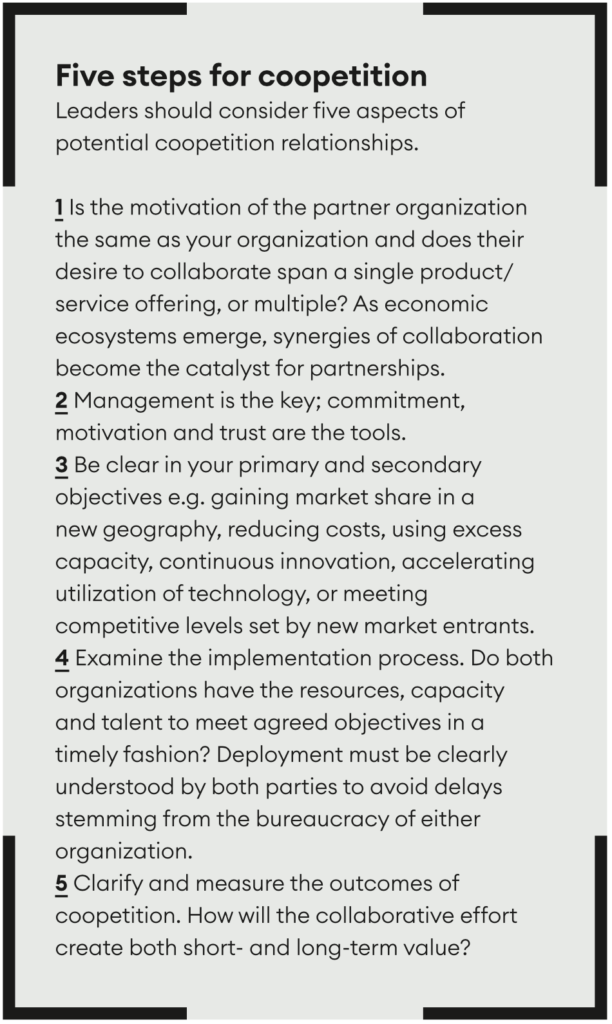Leaders need to simultaneously cooperate and compete
In the emerging global economy, companies are realizing that a substantial part of their value proposition rests on their ability to forge relationships to add value to their customers.The environment for business is continually changing: technology has enabled new levels of international trade and economic interdependence, and at the same time, a range of exogenous factors, such as pandemics, changing political agendas and shifts in consumer preferences, have created economic boom and bust cycles.
Some firms will face a choice between learning to collaborate or facing closure. Survival is a powerful motivator. In the post-Covid economy, coopetition – simultaneous cooperation and competition between organizations for customers and market share – will come to the fore.
Crisis, coopetition and strategy
For companies, an economic crisis is like an inspection: it exposes the areas in sales and supply chains or internal processes where strategies are not as robust as they could be. Where there are failure points, there is the potential for collaboration with external entities to add value.
Coopetition can take many forms in support of strategic initiatives, including reaching new geographic market segments, utilizing excess capacity, sharing costs, expanding distribution channels, joint marketing campaigns, innovation projects, and mitigating risks. In effect, coopetition is the externalization of gaps in current capabilities or corporate competencies – gaps which can be filled by a competitor without detrimental impact on the core product or service.
For coopetition to add value, the capabilities and productive output of the whole need to be greater than the sum of the parts. Senior executives need to ask themselves: can the organization operate synergistically in a network of value to generate a value proposition or output that is greater than that which can be achieved by the sum of the individual organizations? In a coopetition-based environment, an organization has to rethink its product or service from the perspective of the customer, who now has to navigate to your node on the network by looking for its intrinsic relevance to their need.
The deal is only the start
By its very nature, coopetition between competing organizations will be unstable and evolving as market conditions change. Instability occurs when the direction of the market varies due to factors like changes in consumer preferences, regulations or tax levies, new product designs or changes in the supply chain. Any coopetition arrangement must be considered as a dynamic process often based on time-dependent factors, which in turn is difficult to record in legally binding agreements.
Senior executives need to consider four key principles:
- The interdependence must be the source of value
- The location and timing of value must be coordinated to avoid cannibalization of existing activities by both parties
- The benefits to each party must be clearly defined, even if they are not shared equally
- A positive sum game must result from convergent interests.
In the airline industry, the formation of the Star Alliance network of competing airlines – which started in 1997 with five airlines, and now comprises 26 international and regional airlines globally – was established to save on logistics, marketing and ticketing costs. In the automotive industry, the alliance between Daimler and BMW shows that formerly fierce competitors can move to coopetition: their partnership on mobility is helping them to compete with companies such as Lyft, Uber, and China’s Didi Chuxing.

Management commitment
The business case for coopetition may be persuasive, but managing the interplay of organizations in pursuit of both common goals and separate corporate objectives undeniably creates challenges for leaders. Most managers are uncomfortable with the contradictions implicit in the very concept of coopetition, but creating synthesis is a proven approach.
Managers must learn to simultaneously hold a cooperative and competitive mindset in all parts of their strategic thinking.
A multifaceted approach to coopetition will help companies neutralize weaknesses and rapidly capitalize on new opportunities. It will be an essential part of the ‘new normal’ post-Covid.

